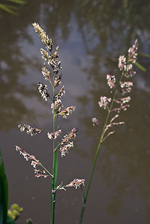|
||||||
|
PHALARIS. Canary-grasses. [Poaceae] |
|
|
Eleven species of Phalaris are recorded in Britain. These include the native Reed Canary-grass (P. arundinacea). Twenty-three miners are recorded on Phalaris. Nearly 100 British miners or possible miners are recorded on grasses in Britain. A key to the European miners recorded on Phalaris is provided in Bladmineerders van Europa. It is recommended that adults of all miners on grasses be reared to be certain of their identity. |
|
Key for the identification of the known mines of British |
||
Note: Diptera larvae may live in a corridor mine, a corridor-blotch mine, or a blotch mine, but never in a case, a rolled or folded leaf, a tentiform mine or sandwiched between two more or less circular leaf sections in later instars. Pupation never in a cocoon. All mining Diptera larvae are leg-less maggots without a head capsule (see examples). They never have thoracic or abdominal legs. They do not have chewing mouthparts, although they do have a characteristic cephalo-pharyngeal skeleton (see examples), usually visible internally through the body wall. The larvae lie on their sides within the mine and use their pick-like mouthparts to feed on plant tissue. In some corridor miners frass may lie in two rows on alternate sides of the mine. In order to vacate the mine the fully grown larva cuts an exit slit, which is usually semi-circular (see Liriomyza huidobrensis video). The pupa is formed within the hardened last larval skin or puparium and as a result sheaths enclosing head appendages, wings and legs are not visible externally (see examples). See Key to non-Diptera. |
||
1a > Leaf-miner: Broad mine that starts at leaf apex. Frass in large clumps. Pupation usually external. Pupariu black. |
||
|
||
Cerodontha phalaridis Nowakowski, 1967 [Diptera: Agromyzidae]. |
||
1b > Leaf-miner: Larvae feed singly, forming an upper surface linear-blotch mine. Pupation either internal or external, with the puparium loosely glued to the leaf (Spencer, 1976: 91). Oviposition near the leaf margin, at some distance from the leaf tip. From there develops an upper-surface corridor-blotch. At first the mine ascends as a narrow corridor towards the leaf tip, then the direction turns and the mine, steadily widening, descends in the direction of the leaf base. Frass irregular, in rather coarse grains. Larva solitary. Pupation mostly outside the mine; in that case the puparium often sticks to the leaf. |
||
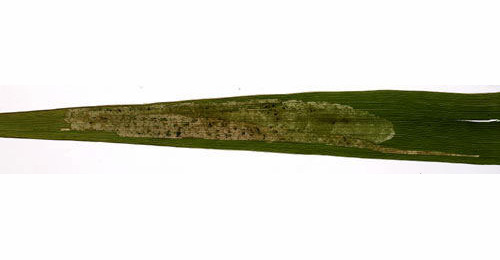 Mine of Agromyza albipennis on Phalaris arundinacea Image: © Willem Ellis (Bladmineerders van Europa) |
||
|
||
Agromyza albipennis Meigen, 1830 [Diptera: Agromyzidae]. |
||
1c > Leaf-miner: The young larva first feeds towards the apex of the leaf, later turning and feeding downwards. Several larvae can occur together in a single leaf. Pupation external (Spencer, 1976: 130). Upper-surface, greenish, gradually widening corridor, at first running towards the leaf tip, then reverses. Through fusion of several mines the final mine is often communal. Frass in backish green grains, often washed out. Pupation outside the mine. Puparium reddish brown |
||
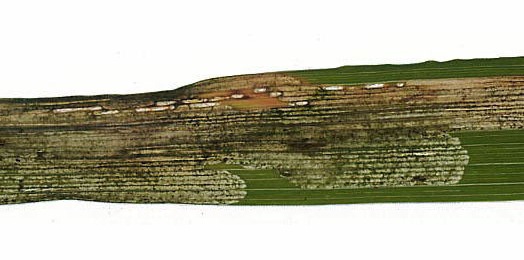 Mine of Agromyza nigrociliata on Arrhenatherum elatius Image: © Willem Ellis (Bladmineerders van Europa) |
||
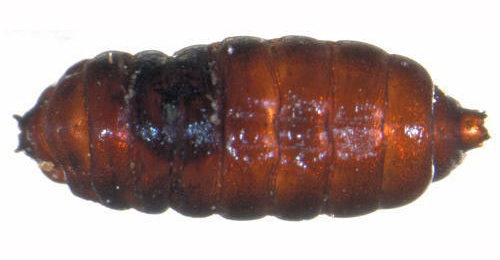 Agromyza nigrociliata puparium Image: © Willem Ellis (Bladmineerders van Europa) |
||
|
||
Agromyza nigrociliata Hendel, 1931 [Diptera: Agromyzidae]. |
||
1d > Leaf-miner: Long upper-surface corridor usually containing several larvae that graze shoulder to shoulder from the leaf tip downwards. Pupation outside the mine. Mines and larvae are indistinguishable from those of A. nigrella. |
||
|
||
Agromyza mobilis Meigen, 1830 [Diptera: Agromyzidae]. |
||
1e > Leaf-miner: Larval leaf-mine starts as a narrow channel running towards apex of leaf but later develops into a broad blotch running downwards. Frass largely diffused, giving the mine a characteristic greenish appearance. Pupation external (Spencer, 1976: 126). Corridor, usually several in one leaf, running from close to the leaf base up to near the tip, then reversing direction and widening, resulting in one communal mine in which the larvae descend in a common front. Frass somewhat deliquescent, mine therefore strikingly green. Pupation outside the mine. Neither mine nor larva distinguishable from those of mobilis. Puparium reddish brown |
||
|
||
Agromyza nigrella (Rondani, 1875) [Diptera: Agromyzidae]. |
||
1f > Leaf-miner: Larvae feeding singly, forming a long, widening mine on the upper surface of the leaf, which is generally limited to one side of the leaf. Pupation external, puparium glued to the leaf near the end of the mine (Spencer, 1976: 128). Broad corridor, generally beginning near the leaf margin or close to the leaf tip. Most of the times the mine remains at one side of the midrib. The mine is upper-surface, but has some full depth, translucent spots here and there. Frass in rather regularly scattered grains. Pupation outside the mine. According to Dempewolf (2004a) only the male genitalia enable a reliable discrimination from A. abipennis and A. graminicola. |
||
|
||
Agromyza nigripes Meigen, 1830 [Diptera: Agromyzidae]. |
||
1g > Leaf-miner: Larva feeds mainly in the leaf sheaths. The short mines which may be formed in the leaf blade may be easily overlooked. Pupation internal (Spencer, 1976: 178). Mine begins as a narrow, usually upper-surface, occasionally lower-surface or interparenchymatous corridor in the blade, that descends towards the ligule, thence continues into the leaf sheath, generally on its inside. Usually only one mine per leaf. Puparium in a puparial chamber at the margin of the leaf sheath. Neither mine nor larva can be distinguished from that of C. fulvipes that, as far as is known, only feeds on Poa trivialis. |
||
|
||
Cerodontha denticornis (Panzer, 1806) [Diptera: Agromyzidae]. |
||
1h > Leaf-miner: A linear mine running towards the apex of the leaf and this can widen and become almost blotch-like. Pupation internal (Spencer, 1976: 194, 195 (fig. 340). Upper surface corridor, mostly in the lower half of the blade, running upwards, and never occuping more than half the width of the leaf. Larva solitary. Frass in green smears. Pupation inside the mine. |
||
|
||
Cerodontha lateralis (Macquart, 1835) [Diptera: Agromyzidae]. |
||
1i > Leaf-miner: Normally several larvae feed together. Pupation in the mine. Puparium shining black (Spencer, 1976: 198). Broad elongated blotch. Frass greenish. Larvae generally communal. Pupation within the mine. The black puaria are individially anchored within the mine with a silken thread attached at their rear end. Distinguishable from C. incisa only by means of the larva. |
||
|
||
Cerodontha pygmaea (Meigen, 1830) [Diptera: Agromyzidae]. |
||
1j > Leaf-miner: Broad lower surface mine which generally starts at the leaf apex.The mine is somewhat irregular in depth. Frass in irregular black-green, frequently melted grains, mostly along the edges of the mine. Larva solitary. Pupation generally internal. |
||
|
||
Cerodontha muscina (Meigen, 1830) [Diptera: Agromyzidae]. |
||
1k > Leaf-miner: Broad elongated mine; the form is dependent of the leaf form of the host plant. Frass green. Usually a number of larvae together in a mine. Pupation in the mine. |
||
|
||
Cerodontha incisa (Meigen, 1830) [Diptera: Agromyzidae]. |
||
1l > Leaf-miner: Long, narrow, whitish mine. Pupation internal (Spencer, 1976: 453); anterior spiracles projecting through the epidermis. Whitish, upper-surface, rather narrow corridor with comparatively large frass grains that are laying further apart than their diameter. Pupation within the mine. The anterior spiracles of the orange-brown puparium penetrate the epidermis. |
||
 Chromatomyia nigra larva, lateral Image: © Willem Ellis (Bladmineerders van Europa) |
||
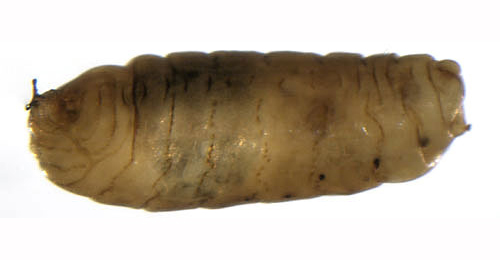 Chromatomyia nigra pupa, lateral Image: © Willem Ellis (Bladmineerders van Europa) |
||
|
||
Chromatomyia nigra (Meigen, 1830) [Diptera: Agromyzidae]. |
||
1m > Leaf-miner: Narrow whitish mine, with frass in distinct black lumps. Pupation internal (Spencer, 1976: 422). Whitish, upper-surface, descending corridor, about halfway up the blade. Frass in distinct black grains that are lying further apart than their diameter. Pupation in the mine. |
||
|
||
Chromatomyia fuscula (Zetterstedt, 1838) [Diptera: Agromyzidae]. |
||
1n > Leaf-miner: A narrow whitish linear mine, running down the leaf from the apex, with frass in two rows of separate grains. Pupation external (Spencer, 1976: 246). Narrow corridor from start to end, whitish, uppper- or lower-surface, genarally running downwards. Mine often along the leaf margin. Frass in distict grains of regular size, alternating along the sides of the corridor. Pupation outside the mine. |
||
 Mine of Liriomyza flaveola on Festuca gigantea Image: © Willis Ellis (Bladmineerders van Europa) |
||
|
||
Liriomyza flaveola (Fallén, 1823) [Diptera: Agromyzidae]. |
||
1o > Leaf-miner: A short narrow mine, generally near apex of leaf. Larva with each segment bearing a row of characteristic papilli which are retained in the puparium (Spencer, 1976: 328). Pupation internal. Transparent, short and narrow mine not far from the leaf tip. Frass in two rows of grains. Pupation outside the mine. |
||
|
||
Pseudonapomyza atra (Meigen, 1830) [Diptera: Agromyzidae]. |
||
1p > Leaf-miner: Irregular mine, locally shallow, elsewhere much deeper, giving it a mottled appearance. In broadleaved plants the mine often begins as a blotch with stellate extensions, but sometimes as a very fine, shallow corridor. In grasses the mine often begins in the leaf sheath. The frass is very fine-grained, initially scattered, later in aggregates. The egg is deposited on the plant surface, and the empty egg shell remains visible. But the larvae are able to leave their mine and restart elsewhere, thus mines without an egg shell can be found as well. The larva also leaves the mine before pupation. Pupation takes place in a newly made, small, blotch mine without frass; this mine may be made in another plant (species). |
||
|
||
|
||
Hydrellia griseola (Fallén, 1813) [Diptera: Ephydridae]. |
|
|
Note: The larvae of mining Coleoptera, Hymenoptera and Lepidoptera may live in a corridor mine, a corridor-blotch mine, a blotch mine, a case, a rolled or folded leaf, a tentiform mine or sandwiched between two more or less circular leaf sections in later instars. Larva may pupate in a silk cocoon. The larva may have six legs (although they may be reduced or absent), a head capsule and chewing mouthparts with opposable mandibles (see video of a gracillarid larva feeding). Larvae of Hymenoptera and Lepidoptera usually also have abdominal legs (see examples). Frass, if present, never in two rows. Unless feeding externally from within a case the larva usually vacates the mine by chewing an exit hole. Pupa with visible head appendages, wings and legs which lie in sheaths (see examples). |
1a > Leaf-miner: In the first instar the larva mines the leaves, forming short, irregular, blotch-like mines, but in later instars it lives externally, feeding in spun leaves and often twisting those of tender shoots. Larval head light-brown or yellowish brown, edged with black postero-laterally, ocellar area blackish; prothoracic plate black edged with whitish anteriorly; abdomen dull dark green; pinacula distinct, black, sometimes brownish but with black bases to setae; anal plate large, black (Bradley et al., 1973). Small, full depth mine without a definite shape; little frass. Some silk is deposited in the mine. The larva soon leaves the mine and continues feeding among spun leaves. |
|
Cnephasia incertana (Treitschke, 1835) [Lepidoptera: Tortricidae]. |
1b > Leaf-miner: Makes long narrow galleries. The frass is distributed through the mine and also some is ejected. The larvae may mine more than one leaf. Elongate, rather irregular blotch. Most frass is ejected, what remains is concentrated in a few heaps. The larva makes several mines. Pupaton outside the mine. |
|
Cosmopterix orichalcea Stainton, 1861 [Lepidoptera: Cosmopterigidae]. |
1c > Leaf-miner: The larva mines from the grass tip downwards and the mine occupies half or the whole of the leaf blade width. A whitish blotch is formed with characteristic narrow streaks of frass. Full depth blotch, slightly inflated, descending from the leaf tip, occupying half or the entire width of the blade. The larva may move and make a new mine elsewhere. In the latter case the mines are fairly short; otherwise an entire blade may be mined out. Frass in a some narrow greyish brown streaks. Pupation outside the mine. |
|
Elachista albifrontella (Hübner, 1817) [Lepidoptera: Elachistidae]. |
1d > Leaf-miner: In autumn the larva makes a narrow corridor a few cm in length, in which it hibernates. In March it moves to a new leaf. Here a transparent, full depth mine is made that descends from the leaf tip, and occupies the entire width of the blade. Most frass is concentrated in the oldest, highest, part of the mine. The larva may leave its mine and restart elsewhere. Pupation outside the mine |
 Mine of Elachista argentella on Dactylis glomerata Image: © Ben Smart (British leafminers) |
|
Elachista argentella (Clerck, 1759) [Lepidoptera: Elachistidae]. |
1e > Leaf-miner: In spring a short corridor is made that is almost stuffed with frass. After hibernation this mine is vacated, and the larva then makes a number of elongated blotches, all descending from the leaf tip. These latter mines are whitish, with irregularly scattered frass. |
|
Elachista humilis Zeller, 1850 [Lepidoptera: Elachistidae]. |
1f > Leaf-miner: Larva makes a large whitish blotch and mines the leaf downwards. The frass tends to be deposited in the upper part of the mine. Oviposition usually not far from the leaf tip. From there descends an irregular blotch mine. Hering (1957a) describes the mine as flat and quite shallow, giving it a greenish, rather than whitish appearance. Frass initially in the oldest, upper part of the mine, later in strings. The larva can leave its mine and restart elsewhere. Normally only one larva per mine, but sometimes two or even three mines in a leaf. Pupation outside the mine. |
|
Elachista maculicerusella (Bruand, 1859) [Lepidoptera: Elachistidae]. |
1g > Leaf-miner: The mine begins near the leaf tip and descends towards the base. The mine occupies the entire width of the blade. Frass initially scattered, later in an irregular central line. Fully developed mine c. 8 cm long. Probably the larva is capable of leaving its mine and restarting in another leaf. Pupation external. |
| On Calamagrostis epigejos, but not yet on Phalaris, in Britain and Avena, Calamagrostis, Glyceria, Phalaris and Poa elsewhere. Cambridge and East Norfolk in Britain. Widespread in continental Europe. |
| Elachista pomerana Frey, 1870 [Lepidoptera: Elachistidae]. |
| Last updated 06-Jul-2019 Brian Pitkin | ||

